-
 Bitcoin
Bitcoin $106,754.6083
1.33% -
 Ethereum
Ethereum $2,625.8249
3.80% -
 Tether USDt
Tether USDt $1.0001
-0.03% -
 XRP
XRP $2.1891
1.67% -
 BNB
BNB $654.5220
0.66% -
 Solana
Solana $156.9428
7.28% -
 USDC
USDC $0.9998
0.00% -
 Dogecoin
Dogecoin $0.1780
1.14% -
 TRON
TRON $0.2706
-0.16% -
 Cardano
Cardano $0.6470
2.77% -
 Hyperliquid
Hyperliquid $44.6467
10.24% -
 Sui
Sui $3.1128
3.86% -
 Bitcoin Cash
Bitcoin Cash $455.7646
3.00% -
 Chainlink
Chainlink $13.6858
4.08% -
 UNUS SED LEO
UNUS SED LEO $9.2682
0.21% -
 Avalanche
Avalanche $19.7433
3.79% -
 Stellar
Stellar $0.2616
1.64% -
 Toncoin
Toncoin $3.0222
2.19% -
 Shiba Inu
Shiba Inu $0.0...01220
1.49% -
 Hedera
Hedera $0.1580
2.75% -
 Litecoin
Litecoin $87.4964
2.29% -
 Polkadot
Polkadot $3.8958
3.05% -
 Ethena USDe
Ethena USDe $1.0000
-0.04% -
 Monero
Monero $317.2263
0.26% -
 Bitget Token
Bitget Token $4.5985
1.68% -
 Dai
Dai $0.9999
0.00% -
 Pepe
Pepe $0.0...01140
2.44% -
 Uniswap
Uniswap $7.6065
5.29% -
 Pi
Pi $0.6042
-2.00% -
 Aave
Aave $289.6343
6.02%
When should we be alert to the continuous positive lines with large volume at low levels?
Bullish candles with high volume at low prices may signal accumulation or a potential trend reversal, but traders should confirm with resistance breaks and key indicators before acting.
Jun 16, 2025 at 10:56 pm
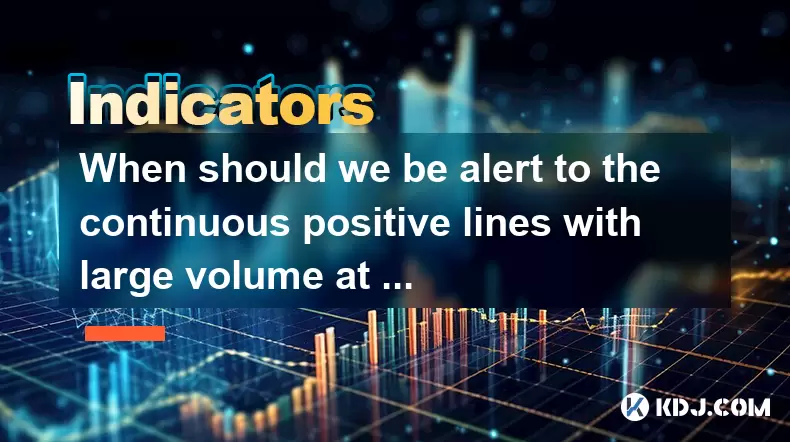
Understanding Continuous Positive Lines in Cryptocurrency Charts
In the world of cryptocurrency trading, chart patterns are essential tools for predicting price movements. One such pattern that traders often observe is a series of continuous positive lines—also known as bullish candles—appearing at low price levels. These lines, especially when accompanied by large volume, can signal potential market shifts. However, they also raise critical questions: What do these patterns mean? When should traders be cautious?
Continuous positive lines with large volume at low levels typically indicate strong buying pressure despite the asset being undervalued or oversold. This could suggest accumulation by institutional players or whales who believe the price has reached a support level.
What Does It Mean When Volume Is High During Low-Price Bullish Candles?
High volume during bullish candlesticks at low prices suggests that buyers are stepping in aggressively. In crypto markets, where volatility reigns supreme, this kind of activity may hint at a reversal from a downtrend to an uptrend.
- Accumulation phase: Smart money may begin accumulating assets at discounted prices.
- Market sentiment shift: A sudden surge in volume can reflect changing investor perception about the project or broader market conditions.
- Technical bounce: Oversold conditions on indicators like RSI or MACD might trigger short-term rebounds.
However, high volume alone doesn't guarantee a reversal. Sometimes, it could be a trap set by manipulators to lure retail traders into false breakouts.
When Should Traders Be Alert to This Pattern?
Traders must pay attention to several key signals before interpreting this pattern as a genuine opportunity or warning sign.
- Confluence with support levels: If the price is near a historical support zone and shows multiple green candles with rising volume, it increases the reliability of the signal.
- Timeframe alignment: A pattern seen on a daily chart is more significant than one observed on a 1-hour chart.
- Volume comparison: The volume should significantly exceed the average volume of previous sessions to be considered meaningful.
Additionally, if the pattern appears after a prolonged downtrend without any major news catalyst, it's likely a temporary relief rally rather than a full-fledged trend change.
How Can We Differentiate Between Genuine Reversals and False Signals?
Identifying whether the continuous positive lines are part of a real reversal or just noise requires technical confirmation.
- Break above resistance: A close above a key resistance level confirms the strength behind the bullish movement.
- Candlestick confirmation: Look for strong continuation candles like engulfing patterns or hammer formations following the initial green lines.
- Moving averages: A cross above the 50-day or 200-day moving average adds credibility to the reversal.
Failure to confirm with these additional indicators increases the risk of entering a trade based on misleading data.
What Risks Are Associated With Acting on This Signal Prematurely?
Jumping into a position solely because of bullish candles and high volume at low levels can expose traders to substantial risks.
- Whale manipulation: Large holders may create artificial demand to entice buyers before dumping their holdings.
- Short squeezes: A rapid rise in price due to shorts covering positions can quickly reverse once the momentum fades.
- Lack of fundamentals: If the underlying project lacks solid development, partnerships, or utility, the rally may not last long.
Therefore, relying only on technical signs without considering the broader context can lead to costly mistakes.
Frequently Asked Questions
Q: How many consecutive positive lines are needed to consider this pattern significant?
There’s no fixed number, but generally, seeing three or more consecutive bullish candles with increasing volume at key support levels is considered a stronger signal. However, always check for other confirming indicators.
Q: Can this pattern appear in altcoins differently compared to Bitcoin or Ethereum?
Yes. Altcoins often experience more volatile swings, so this pattern might be less reliable unless supported by fundamental developments or sector-specific news.
Q: Is there a specific indicator that works best alongside this pattern?
Combining volume analysis with tools like the Relative Strength Index (RSI), Moving Average Convergence Divergence (MACD), and Bollinger Bands can provide better clarity about overbought/oversold conditions and trend strength.
Q: Should I use stop-loss orders when trading based on this pattern?
Absolutely. Since crypto markets are highly unpredictable, placing a stop-loss below the recent swing low helps manage risk effectively and protects capital from sudden reversals.
Disclaimer:info@kdj.com
The information provided is not trading advice. kdj.com does not assume any responsibility for any investments made based on the information provided in this article. Cryptocurrencies are highly volatile and it is highly recommended that you invest with caution after thorough research!
If you believe that the content used on this website infringes your copyright, please contact us immediately (info@kdj.com) and we will delete it promptly.
- 2025-W Uncirculated American Gold Eagle and Dr. Vera Rubin Quarter Mark New Products
- 2025-06-13 06:25:13
- Ruvi AI (RVU) Leverages Blockchain and Artificial Intelligence to Disrupt Marketing, Entertainment, and Finance
- 2025-06-13 07:05:12
- H100 Group AB Raises 101 Million SEK (Approximately $10.6 Million) to Bolster Bitcoin Reserves
- 2025-06-13 06:25:13
- Galaxy Digital CEO Mike Novogratz Says Bitcoin Will Replace Gold and Go to $1,000,000
- 2025-06-13 06:45:13
- Trust Wallet Token (TWT) Price Drops 5.7% as RWA Integration Plans Ignite Excitement
- 2025-06-13 06:45:13
- Ethereum (ETH) Is in the Second Phase of a Three-Stage Market Cycle
- 2025-06-13 07:25:13
Related knowledge

How to confirm the effectiveness of the average price line support in the time-sharing chart?
Jun 17,2025 at 12:56am
Understanding the Time-Sharing Chart and Its RelevanceIn cryptocurrency trading, time-sharing charts play a crucial role in analyzing short-term price movements. These charts typically display price fluctuations over a specific period, often ranging from minutes to hours. Traders rely on them to make quick decisions based on real-time data. The average ...

What does it mean when the momentum indicator breaks above the zero axis?
Jun 17,2025 at 12:43am
Understanding the Momentum IndicatorThe momentum indicator is a technical analysis tool used to measure the speed or velocity of price movements in cryptocurrency markets. It helps traders identify potential trend reversals, overbought or oversold conditions, and confirms existing trends. The indicator typically oscillates around a zero line, with value...
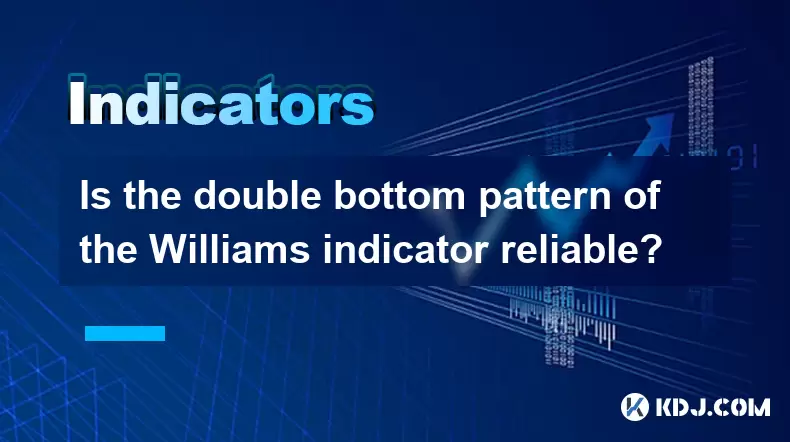
Is the double bottom pattern of the Williams indicator reliable?
Jun 17,2025 at 03:56am
Understanding the Williams Indicator and Its SignificanceThe Williams %R indicator, often referred to as Williams Percent Range, is a momentum oscillator used in technical analysis to identify overbought or oversold conditions in the market. Developed by Larry Williams, this indicator fluctuates between 0 and -100, with readings above -20 indicating ove...
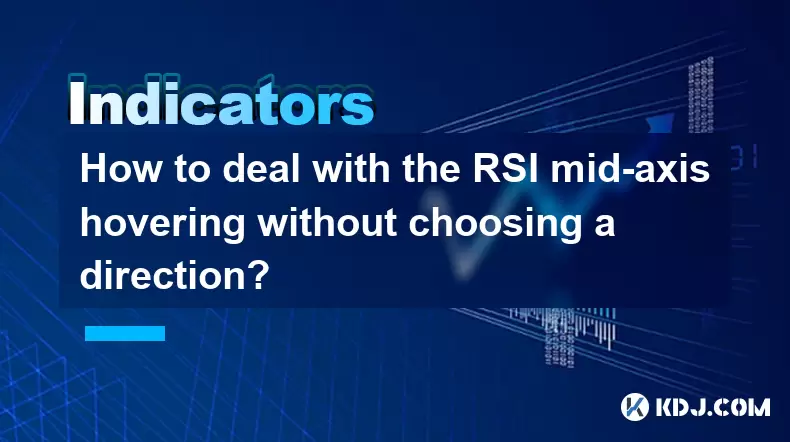
How to deal with the RSI mid-axis hovering without choosing a direction?
Jun 17,2025 at 02:02am
Understanding RSI Mid-Axis Hovering in Cryptocurrency TradingThe Relative Strength Index (RSI) is a popular momentum oscillator used by traders to assess whether an asset is overbought or oversold. In cryptocurrency markets, it's common for the RSI to hover around its mid-axis, typically at the 50 level, without showing a clear upward or downward trend....
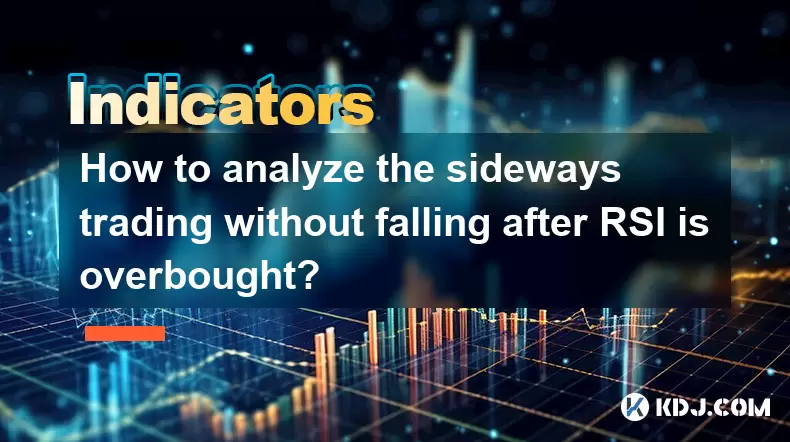
How to analyze the sideways trading without falling after RSI is overbought?
Jun 17,2025 at 04:14am
Understanding RSI and Its Role in Cryptocurrency TradingThe Relative Strength Index (RSI) is a momentum oscillator used to measure the speed and change of price movements. In the context of cryptocurrency trading, it helps traders identify potential overbought or oversold conditions. When the RSI exceeds 70, it typically signals that an asset may be ove...
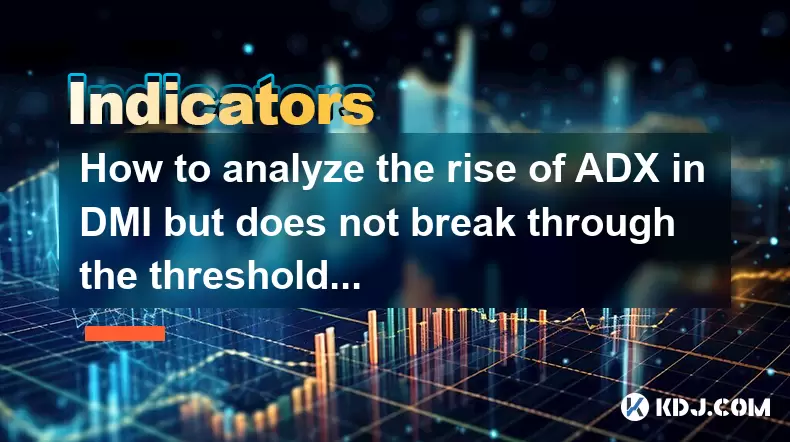
How to analyze the rise of ADX in DMI but does not break through the threshold?
Jun 16,2025 at 11:49pm
Understanding ADX and DMI in Cryptocurrency TradingIn cryptocurrency trading, ADX (Average Directional Index) is a technical indicator used to measure the strength of a trend. It works in conjunction with the DMI (Directional Movement Indicator), which includes two components: +DI (Positive Directional Indicator) and -DI (Negative Directional Indicator)...

How to confirm the effectiveness of the average price line support in the time-sharing chart?
Jun 17,2025 at 12:56am
Understanding the Time-Sharing Chart and Its RelevanceIn cryptocurrency trading, time-sharing charts play a crucial role in analyzing short-term price movements. These charts typically display price fluctuations over a specific period, often ranging from minutes to hours. Traders rely on them to make quick decisions based on real-time data. The average ...

What does it mean when the momentum indicator breaks above the zero axis?
Jun 17,2025 at 12:43am
Understanding the Momentum IndicatorThe momentum indicator is a technical analysis tool used to measure the speed or velocity of price movements in cryptocurrency markets. It helps traders identify potential trend reversals, overbought or oversold conditions, and confirms existing trends. The indicator typically oscillates around a zero line, with value...

Is the double bottom pattern of the Williams indicator reliable?
Jun 17,2025 at 03:56am
Understanding the Williams Indicator and Its SignificanceThe Williams %R indicator, often referred to as Williams Percent Range, is a momentum oscillator used in technical analysis to identify overbought or oversold conditions in the market. Developed by Larry Williams, this indicator fluctuates between 0 and -100, with readings above -20 indicating ove...

How to deal with the RSI mid-axis hovering without choosing a direction?
Jun 17,2025 at 02:02am
Understanding RSI Mid-Axis Hovering in Cryptocurrency TradingThe Relative Strength Index (RSI) is a popular momentum oscillator used by traders to assess whether an asset is overbought or oversold. In cryptocurrency markets, it's common for the RSI to hover around its mid-axis, typically at the 50 level, without showing a clear upward or downward trend....

How to analyze the sideways trading without falling after RSI is overbought?
Jun 17,2025 at 04:14am
Understanding RSI and Its Role in Cryptocurrency TradingThe Relative Strength Index (RSI) is a momentum oscillator used to measure the speed and change of price movements. In the context of cryptocurrency trading, it helps traders identify potential overbought or oversold conditions. When the RSI exceeds 70, it typically signals that an asset may be ove...

How to analyze the rise of ADX in DMI but does not break through the threshold?
Jun 16,2025 at 11:49pm
Understanding ADX and DMI in Cryptocurrency TradingIn cryptocurrency trading, ADX (Average Directional Index) is a technical indicator used to measure the strength of a trend. It works in conjunction with the DMI (Directional Movement Indicator), which includes two components: +DI (Positive Directional Indicator) and -DI (Negative Directional Indicator)...
See all articles

























































































